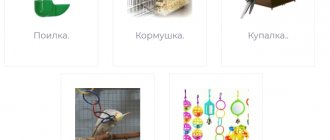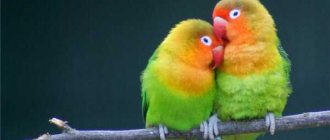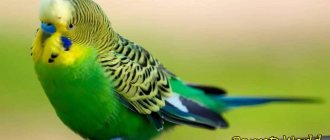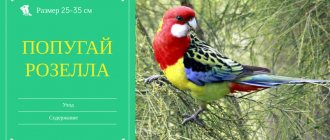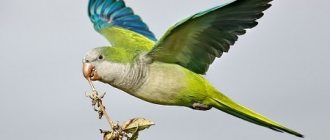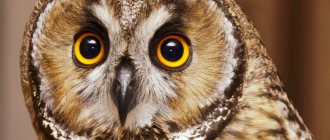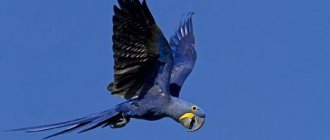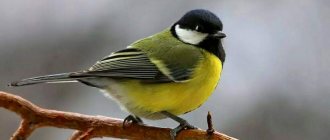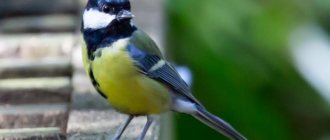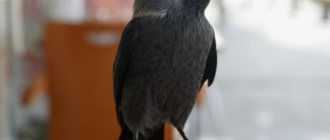Description
The length of the cockatiel's body is about 33 centimeters, 15 of which are allocated under the pointed and “rich” tail. The weight reaches 100 grams, which is about the same weight as a well-groomed pigeon. Many owners claim that the Corella parrot at home is much more tolerant and sociable than its closest relative, the cockatoo. These birds do not fly into a rage and do not destroy objects around them, like cockatoos. Therefore, bright “nymphs” can be safely placed in free enclosures, even in the company of other birds.
Also, many owners noted the friendly bond that a budgerigar and a cockatiel develop at home. Two fairly sociable birds get along well in a common colony, provided there is constant free space and human communication.
For many years, the beauty and unusualness of the "nymphs" was hidden by the abundance of brighter budgerigars. But with the help of scientists and their work on the brightness of their plumage, lovers of ornamental birds learned about the kindness that cockatiels radiate. Reviews from experienced poultry farmers reveal the amazing affection of birds for their owners. Also, the melodic chimes of these birds will not lead to conflict situations with neighbors, which is a pleasant bonus for residents of apartment buildings.
Corella parrot - reviews about the breed
- + Leave a review
Stas
05/04/2021 at 00:13Answer
They write reviews about cockatiels, who are very good at what. He yells in the morning - turn off the lights for him at 24 hours, he will breathe in the morning if necessary until lunch. There is a lot of garbage - place a deep basin-type tray under the cage. The parrot is swearing - maybe they gave him something fatty, maybe they released him and pecked at something inedible, the pancreas got hooked. We don’t even give RIO, but just striped seeds, millet, oats - there were no problems from the market. Yes, a cockatiel is a bird with character, a new owner was either given to someone for a while or left alone for a long time - it is a huge stress for her, and if it is not a nurse or the chick was partially hand-fed - it takes time to tame, hand-feed more often, more communication .
Leave a review Reset
Anna OS
https://otzovik.com/review_3926904.html
Advantages:
- Beautiful
- large parrot
Flaws:
- Apathetic and nasty cry
We took a cockatiel instead of a lovebird (it attacked, pecked and gnawed everything it saw in the room). They called him Kuzenka and he behaved accordingly. He doesn’t like to wash himself in the fountain, and he doesn’t clean his feathers often either.
The first impressions of the cockatiel are pleasant, compared to the cockatiels and lovebirds. The parrot is large, beautifully colored (especially the cheeks) and has a crest on its head, in general a copy of a cockatoo.
He hasn’t learned to talk yet, but his scream is disgusting (even covering the cage doesn’t help). You can feed without special mixtures, just enough grain, seeds, fruits, and you need to buy vitamin supplements. I haven’t noticed any special intelligence yet either.
Polina Space
https://otzovik.com/review_3158043.html
Advantages:
- handsome and smart
Flaws:
- There is not
Very, good parrot!!! smart and beautiful. The head is the color of the sun, you will not regret buying this cockatiel parrot!!! Personally, I didn’t regret it.
Anonymous1131753
https://otzovik.com/review_4442002.html
Advantages:
- Darling!
Flaws:
- A lot of dirt
- vulnerable to diseases
- hard to maintain
- it's hard to teach to speak.
In 2013 we bought a parrot. Before buying, we didn’t read anything about cockatiels, so we went to the pet store without thinking. I regret this. At the pet store they told us that the parrot was 7-8 months old, I really liked him. It was a boy. We named him Kesha. Of course, it is better to buy a parrot when it is still a chick, at 1-3 months, in order to raise it earlier and teach it to speak. Kesha was very mischievous, he never let anyone near the cage, he always grumbled and bit. But that’s how you talk to him) I started him to respond to my name) Every time I came home, Kesha said! And he: Tweet! This is how you can teach him to respond. Kesha, of course, didn’t say anything, I think it was late in life. Sometimes annoying, constantly muttering under his breath and chirping at night. It makes a lot of dirt, feathers, droppings, and when they eat food it flies in different directions. He can always misbehave.
We kept him properly and fed him good Rio food. But yesterday, February 1, 2022, disaster happened. I came home, Kesha was sitting where he usually was in his place outside the cage. There were some white spots near the cage. Next, Kesha, as always, responded to his name, and then I noticed liquid droppings. He has diarrhea. We gave him smecta, rice porridge, and warmed him up, but he got worse and worse. He can't climb onto his perch. We put him in a cage and he sat on the floor. He was sitting, holding the cage with his beak. I was so worried. Soon he fell, began to breathe, breathe, froze and that’s it. That was the end. I cried so much!!! And now I still can’t believe it. Kesha was my first pet. I loved him despite all his shortcomings!!! I do not recommend getting a parrot, they are very vulnerable to diseases, and they are very, very dirty. The parrot lived with me for about 4 years. I don't know how old he is. At the time of purchase, the store said that it was 7-8 months old, so now he was 4 years old.
mazitova-venera
https://otzovik.com/review_5975829.html
Advantages:
- a lot of pleasant emotions)
Flaws:
- food, crumbs and feathers wherever possible
- daily cleaning
My daughter asked for a parrot for her birthday, my dad gave him a cockatiel for a boy with a large cage and all sorts of drinking bowls and feeders. My daughter named him Kesha (apple cheeks, that’s what we called him). At first he was afraid of us, adaptation and all that. The door was never closed, and he never flew out, it’s surprising why. Sometimes Kesha clings with his beak and paws and climbs out of the cage, but does not fly because he does not know how. I tried to fly and fell on the floor, poor thing, I’ve probably never flown even once in my entire life. I also thought that they probably always kept him locked up. We came across the vociferous Kesha, singing songs). A year later they bought him a girlfriend, her daughter named her Anfisa. There she was, yes, flying all over the apartment))) And Kesha (the downed pilot) was calling her back.
Forestrals
https://otzyv.expert/ptichka-zhivet-15-mesyaca-u-nas-i-uzhe-est-rezultat-vam-tozhe-napisala-neskolko-rekomendaciy-1490536
Advantages:
- funny
- affectionate bird
- in this review you can read some recommendations about how we tamed
Flaws:
- We have no cons yet, the bird has been living with us for 1.5 months
We bought our cockatiel Yasha 1.5 months ago. I hope we weren’t deceived when they said that it’s a boy and he’s 3 months old (he’s already 4 now and he’s just starting to sing a little), so there’s every reason to think that the breeder is conscientious. When we bought him, he was already walking on a stick (the breeder taught him to do this), but he was afraid of hands. A month later, we gradually got him used to being held (now he walks on his arm) and sits on his shoulder and you can walk around the apartment with him. Also, when we sit on the kitchen table, he begins to move down from his shoulder down his arm, and we gave him buckwheat from a spoon. This is how mom gets used to us little by little, and within a month of his stay we can see the results. When I was a child, I had wavy trees, and they produced a lot of garbage; in any case, ours doesn’t have any garbage (although I hear from many that there is a lot of garbage). We don’t close the cage, he lives freely with us, we also made him a playground so that he had his own place to sit, I didn’t want him to sit on the furniture. We don’t cover the cage with a blanket at night, at least until he wakes us up, I can’t say that he’s noisy, he rarely screams. But this is my review of his month and a half stay with us, I hope everything will be fine in the future. Regarding taming, try taming with a stick, and not directly with your hands; give food on a spoon. You place the stick under the belly, closer to the paws, and he will climb onto it himself. Be patient and you will succeed, we are in the process of raising our bird.
Seriken
https://otzyv.expert/ne-ponravilsya-1659459
Advantages:
- Handsome
- big
Flaws:
- Bites hard
- a lot of dirt
- scribbles loudly
Good day. I want to share my experience about this breed of birds. Since childhood, I have dreamed of a parrot larger than a budgie, and then one day I saw this bird for sale at the market, and I was inspired to buy it! Why! After all, that was my dream! And so I bought it - at first I was delighted with it, but later I began to notice its shortcomings. It didn’t give in to your hands, and if you caught it, it bit worse than the wavy one - its beak is powerful, it bites through the skin instantly - so it’s scary to catch, I was even afraid that my daughter would stick her finger to it - which is what she tried to do, it’s garbage from him too - mom Don’t worry, and even in the morning he screams so hard his ears are blocked, they put him in the kitchen, away from him. So my dreams did not come true, the bird is beautiful but creates a lot of inconvenience.
Oksana1308
https://irecommend.ru/content/prevykaesh-trudno-rasstavatsyarevela-ves-den
Advantages:
- funny
- beautiful
- curious
- you can teach to talk
- charming
- smart
If you have a living creature in the house, it would be a parrot. We bought it at the poultry market in Chelyabinsk. In a cage on a perch there were 5 of them, identically yellow, with tufts and red cheeks. The choice fell on our Chiga because he somehow brazenly stretched his head higher than the rest and looked at us intently. The parrot turned out to be a little cowardly, he was afraid to leave the cage for so long, but maybe it was for the best, since his friends also liked to chew wallpaper. Ours was “modest”. moderately loud, picky eater, cowardly. I didn’t eat fruits or vegetables - I was afraid to go near them. He ate mostly purchased food and grain sticks. These parrots love to swim. We watered him from a weak shower, and he spread his wings and exposed him, one by one, to the spray of water. In general, we got used to Chiga, lived for 5 years until I fell ill on hot sunny summer days. She rushed to treat him with medicine, fed him and gave him water from a pipette. But, as I read somewhere, if a bird is sick, then it is useless to treat. He literally died in his arms. It turned out to be very difficult - we got used to it. She cried all day and the next. I swore not to have any more animals or birds. But when I go to a pet store with my child, my soul just asks for a bird to come into the house...
come in large numbers
https://www.u-mama.ru/forum/family/pets/193122/
Corella screams like a victim!
Daria96
https://irecommend.ru/content/vse-chto-nuzhno-dlya-zdorovya-popugaya
Advantages:
- beautiful
- you can teach to talk
- smart
Flaws:
- screams
Hi all! If you are interested in parrots (I have a cockatiel), their nutrition and maintenance features, welcome))
I’ll start my story by saying that our parrot has been living with us for almost 6 years. It must be said right away that if you don’t have a great love for parrots, then you shouldn’t take it on - you just don’t have the patience. Moreover, this is a great responsibility, because his life and health will be completely in your hands.
So, let's move on to nutrition: the basis should be grain mixtures and seeds (sunflower, pumpkin). Bird breeding specialists make a special mixture, which consists of grated carrots, a boiled egg and ground crackers of ordinary bread (this fills the parrot’s body with vitamins for the day). There should also be fruits and berries (apple, banana, grapes, pear, plum, watermelon, melon. In general, according to the season. But citrus fruits are not allowed!!), vegetables (cucumbers, carrots). And be sure to have small pebbles, ground eggshells and a piece of ordinary coal in a separate feeder, so that the parrot’s digestive system works well (you remember that in birds, food is “ground” in the goiter with the help of sharp pebbles). You yourself will notice that the parrot will come to this feeder from time to time when necessary. And, of course, there should always be clean water.
Of course, to be healthy, parrots must receive a certain dose of physical activity every day. I taught my parrot to play catch all over the apartment. You give him a load and just have fun.
You also need to bathe your parrot from time to time. Usually it is recommended 1-2 times a week in hot weather, less often in cold weather (once every 1-2 weeks). Here you must find an approach to your parrot. The main thing is not to force him or drag him into the water by force. This way you can only achieve fear of water. I used to put a plate of water on the table and kind of play in it with my hands. The parrot became interested and climbed into the water himself. Now he is bathing under the tap.
Ok, here are the basic rules to follow to keep your parrot healthy. I'm attaching a photo of my pet in case you're interested.
Health to you and your pets!
Tatyana Tais
https://flap.rf/Animals_and_plants/Corella
Our parrot Ksyusha has been living with us for 6 years now.
The smartest creature. She absolutely understands everything. It seems to me that he even understands speech. And the way she captures intonation is simply amazing.
You talk to her kindly, she immediately runs up and lets chat (she is a talker), and if you start reprimanding her for something, she will hide in a corner and look out from there with a guilty look.
It's just a dog with feathers. :)
anilaua
https://irecommend.ru/content/eto-prosto-nevynosimo
Advantages:
- beautiful
Flaws:
- gets up at 5 am
- screams wildly
- screams
- bites painfully
- litters
I don’t like to paint beautifully, so I’ll say it to the point.
The Corolla was bought secondhand, and the first thing she did when she got to me was to SCREAM! The scream was so loud that even if you closed your ears you could hear everything and you just wanted to run away. Well, I think the bird is scared of the new environment, I waited for a week, all this time my parrot was screaming heart-rendingly. Nothing helped at all...he didn’t let anyone in, he just yelled and yelled and yelled. When he more or less stopped, namely, he only screamed in the morning (he started at 5 a.m. and ended the concert at , I decided to make contact with the bird. Little by little, drop by drop, I taught him to sit on my hand, I spent an hour a day 2 to him. What did this lead to? You can say that I am a bad housewife, that constant contact is needed, etc. But it was to no avail: he hissed, bit, did not allow himself to be touched and screamed. So I suffered with him 2 years, all these 2 years I was desperately trying to get in touch with the bird.
I HAVE NO MORE STRENGTH!
Enough is enough, this is UNBEARABLE anymore. I don’t know what the reason is... maybe I didn’t please him with his face, but I’m tired of walking around with my fingers bitten until they bleed, constantly cleaning up after him (and he sheds incredibly and, excuse my French, shits). You can throw stones at me, but I won't touch him again. My destiny is to feed and clean the cage. I read that he sings beautifully and knows the words. I don’t know if he’s a dunce like me, or if I don’t understand something, but he “sings” terribly. It's like jumping on a rubber toy. And of course he yells. If I could convey this scream... it seems to me that in hell even the sounds are more pleasant than this.
The veterinary clinic said that the bird was healthy, it just had that kind of character.
Sorry, but in the morning he is screaming so hard that you really want to strangle him. These “extra” hours I want to sleep, and not get up at 5 am and put on earplugs. The neighbors also constantly complain, and that’s how I became a worse neighbor than the “drill neighbor.”
And now briefly:
- beautiful bird
- bites until you bleed
- constantly screams
- not amenable to training
- hisses
- doesn't sing beautifully
Natalia Istomina
https://flap.rf/Animals_and_plants/Corella
I was bored at home, so I asked my husband to buy a pet, preferably a dog. So, 3 years ago, a Correll parrot appeared in the house. It is often written about this species that they are easy to care for and there is no hassle at all, but for a beginner, the first weeks with a bird turn into a minor disaster.
This bird is not small, it is much larger than the wavy one, so a large cage is needed. The Corrells rarely talk. Ours mostly parodies some sounds, but there is no speech. As for ingenuity, I agree on this. We really have a lot of intelligence, but more mischief.
He doesn’t eat everything, he needs to buy more expensive food so that all his favorite grains are there. Yesterday's food left in the feeder will not peck. It will squeal throughout the entire apartment, but it won’t eat until you throw out the old one and put in a new one. He loves sticks with fruit. But as soon as you hang it, he immediately throws the food in the feeder and starts tearing at the stick. If he removes his wand, he starts screaming. Once he even refused to eat and demanded the chopstick back.
There is no particular smell from this bird, unless you forget to change its “pot”, wash the cage once every 2 weeks, and do not forget to “bathe” the parrot. It is very important to buy a stone for him, preferably a cuttlefish shell, and toys, so he will be busy and less interested in the paper that lies in the “toilet” tray.
Now, 3 years later, of course it’s not difficult to take care of our butt. More attention is paid to the “friendship” of the cat and the parrot.
Tatiana_83
https://irecommend.ru/content/pust-menya-zakidayut-kamnyamino-eto-ne-popugai-eto-terrorist
Advantages:
- beautiful
- smart
Flaws:
- screams wildly
- bites painfully
Good day to all!
Since childhood, various animals lived in my house: a rabbit, a rat, there were budgies, finches.
Now we have a dog. And so my husband also wanted to get a bird... We went to the pet store and took a long time to choose and still he liked the cockatiel.
What can I say, the parrot is not at all stupid, learns quickly, is energetic and has character!
Already on the second day he got used to the hand, completely settled in and adapted. It seems not a parrot, but a gift from above))) But there is one SIGNIFICANT minus - this is his terrible OR!!! This can’t be called singing, it’s just some kind of ultrasound, this “melody” just breaks my head and my husband’s, it really makes me depressed.
Every morning from 6.00 he is on a roll and so on until 21.00, if his cage is not opened, our Kesha knocks down the door with his beak. We tried covering the cage with a blanket - no result! Sometimes he is silent for half a day, but if he starts to calm down... If he is not in the mood, he hisses wonderfully
We've had him for two months now and it's impossible to get used to it!!!! I wanted to give it to someone, but no one wants it (((So we live with this terrorist.
I’ll definitely never get a cockatiel again and I’ll talk my friends out of it.
Colors
The many-faced cockatiel parrot, whose photo adorns our article, has in recent years introduced the world to several new amazing varieties of color:
- Albinos have become an enchanting discovery in the world of poultry breeders - the completely white (in the case of the male) color is favorably set off by red eyes, and the upturned crest remains the usual yellow (sometimes lemon-colored). Females may be cream-colored and have pale spots on the body; their color is noticeably duller than males;
- Pure white (with the usual black eyes) cockatiels are obtained due to the gray dominant male, who carries the gene for sparkling whiteness. It is this subspecies that is distinguished by a dizzying lemon coating on its feathers, males are distinguished by two long tail feathers of a perfect snow-white color, and females are content with a yellow tail;
- cockatiels the color of piquant cinnamon are obtained due to disturbances in the biochemical transformations of parrots. In this color, the above-mentioned tone completely replaces the usual gray;
- lutino - a masterpiece of red eyes and sunny yellow plumage. This is the only cockatiel parrot, the male of which completely matches the color of his female;
- Sheki are the most colorful color of this bird. The combination of gray and completely white spots in complete symmetry gives rise to an ambiguous image of parrots, ideal for crossing new colors. It is the necks that become the most productive foundation for experiments with color.
There are also mother-of-pearl cockatiels, which are incredibly original, but the color of the males changes during the maturation process. Over the past few years, active developments have been underway to eliminate this defect. On the basis of mother-of-pearl individuals, pearl-brown or a mix of mother-of-pearl and spectacular lutino may appear.
Where to keep it?
Their playful nature will help you understand how to tame a cockatiel parrot. Bright birds are lovers of toys, so when choosing an aviary, it is worth considering this feature of birds. Due to their peaceful nature, cockatiels can safely live with each other in a 100x40x60 cage. The main nuance is the environmental friendliness of the selected materials. Wooden rods should not be taken into account - the mobile and powerful beak of cockatiels will destroy this obstacle.
The bars of an enclosure or cage should be positioned strictly horizontally, since mischievous people also like to climb the bars with a song at the ready. Toys or other accessories should be stirred evenly, but care must be taken that they do not interfere with their free movement.
An abundance of toys is not the best option for a cockatiel; the correct tactic for living with parrots of their species would be to constantly alternate the arsenal of entertainment, as well as install ropes.
Taming, feeding and keeping a cockatiel parrot
It is worth taming a cockatiel almost from birth; on its 20th day, the smart chick already begins an independent life. It is during this difficult period that the pet needs attention and care. To win over your bird, you should find out from professionals what to feed your cockatiel parrot. In freedom, graceful birds feed on fruits, small insects and eucalyptus, but in captivity it is worth diversifying the birds’ diet with grain mixtures and mineral supplements. It is worth feeding unusual chicks every 5 hours with 20 ml of the mixture, and an adult parrot can safely eat about 30 grams of the mixture at a time.
Also, handsome cockatiels are true admirers of their neatness, so the cage should be equipped with a bathing area. It is also allowed to spray birds with a spray bottle, following the example of a shower.
Diseases and their treatment
Corella parrots are susceptible to a fairly large number of different diseases. Therefore, if you notice that your feathered pet has begun to breathe heavily, has signs of diarrhea, has stopped eating, or has started to lose feathers, it is recommended that you immediately contact your veterinarian. This is very important, since it is simply impossible to make a diagnosis on your own, much less choose the appropriate treatment.
The most common diseases are:
- Conjunctivitis. For treatment, use “Furacilin”, one tablet of which is diluted in a glass of warm water, and the eyes are washed with the solution.
- A goiter disease that occurs due to poor nutrition and is accompanied by a disorder of the digestive system. In this case, the bird is given activated carbon, which helps remove toxins from the body.
- Feather loss typically occurs every 6 months. This is a planned molt. Therefore, there is no need to worry. But if at the same time wounds appear on the parrot’s body, then the reason is most likely parasites, which can be gotten rid of with the help of special ointments.
- If your pet refuses to eat and there is discharge coming out of his nose, then this is a sign of a cold. In order for the bird to recover quickly, it is necessary to place the cage with it in a warm place, protected from drafts, and also provide good nutrition, rich in vitamins.
It is worth noting that if any symptoms appear, it is recommended to immediately contact a veterinarian.
Talkativeness
Many people talk about how talkative birds are. As they say, adult Corella parrots especially love to chat. Feedback from owners dispels this myth - male colorful birds are often noisier than females, especially during the maturation period. To settle common interests, you can teach the bird several phrases (the bird, naturally, does not know how to conduct a constructive and complete dialogue).
What to look for when buying a parrot?
If you like the Corella parrot (expert reviews say that it is very important to be able to choose the right bird), then when purchasing you should pay attention to the color of the plumage, eyes, beak and behavioral factors.
Juveniles have less bright colors than adults, and the tail length is relatively short. On the head of two-month-old parrots you can see a small bald patch, which disappears after the first molt. The young also have black eyes, which become lighter as they grow older, and soft claws that have not yet had time to get stronger, and there is no chic crest on the head, characteristic of this breed of parrots. As for behavioral factors, young birds behave very clumsily and clumsily.
How to teach to speak?
To do this, it is worth making professional inquiries about how to teach a Corella parrot to talk from experienced owners. The golden rule of bird training is the chick's complete trust in its owners. A friendly intonation and personal address to the parrot will help improve the memorization process, especially when your feathered friend is in a playful mood. You can catch a cockatiel in a good mood while eating a treat (selected sunflower seeds - in some way a “dessert” for the colorful bird).
How to teach a cockatiel to talk? Pay attention to the behavior of the bird itself. If you emotionally repeat the same phrases while bathing or feeding a bird, then the bird will sooner or later play the role of a commentator and delight you with a new vocabulary. The main thing is to conduct the exercise in a positive environment without any shouting or swearing. The cockatiel also easily remembers signals from mobile phones or the barking of domestic dogs.
Reviews from cockatiel owners
Owners of cockatiels say that young birds immediately respond to care for them and begin to trust a person. But to tame an adult bird, sometimes it takes weeks and months. What other reviews and tips do owners share about pets?
Owners often describe these parrots as sensitive, gentle creatures. The behavior of feathered pets greatly depends on the attitude of the owner towards him. You cannot offend, neglect, or ignore birds such as the Corella parrot.
After purchasing, you need to make an effort to tame the pet.
- Be quiet around him. Wait a few weeks for the bird to settle into its new home.
- Talk to your feathered friend constantly. He should hear a calm, gentle voice.
- Gradually, the parrot will get used to you and will begin to come closer as soon as it hears a familiar speech.
- Try offering a treat that the cockatiel parrot loves; owner reviews say that this needs to be done carefully. Reach your hand with the food through the cage, but do not approach the bird. She should come to you herself. Do not move while your pet is getting a treat.
- Continue conversations every day, extend your hand with food, but make sure that the bird does not get nervous. At the slightest sign of dissatisfaction or fatigue, stop exercising.
- Gradually, trust will strengthen and you will become true friends.
Here is the real story of a cockatiel owner:
My bird flew onto the closet and sat there. Impossible to drive... Wild to the point of horror. As soon as he sees the hand, he immediately hisses and shrinks away. He sat like that all day, and by evening he began to raise his voice. Well, of course I was hungry... And then I decided to take advantage of the moment. She took the feeder and brought it to his closet. He hesitated for a long time, and eventually approached the feeder. Then I poured a little on my hand - it didn’t fit. Okay... I took one seed and put it on the closet and walked away. Ate it. So 5 times. Then she took the seed in her hands and brought it to him, hissing. Okay... I put the seed down and stood next to him, he walked around and around for a long time - in the end he took the seed. Then I decided to try giving it with my fingers again. And oh, miracle!!!!!! Took it off my fingers!!! he hissed, but took it. An hour later he was boldly approaching my hands, the next day, as soon as I approached the bird, he immediately looked at my fingers and ran up to me.
Some owners complain that the cockatiel yells, this happens for several reasons:
- This happens when a bird changes its owner. The parrot is frightened by the change of environment and therefore screams. Only patience and affection will help here. Don't react to his screams, just leave the room for a while. When the pet gets used to the new environment, the screaming should stop.
- Sometimes birds attract attention so much, they make it clear to the owner that they are bored and require communication. Play with the parrot, let him fly, and he will calm down.
During the period of adaptation to a new place, and during taming, it happens that the cockatiel hisses. By this he shows that he is dissatisfied with something. Parrots often lose their temper during molting. Then they also hiss and get angry.
If your cockatiel bites, do not jerk your hand away sharply, try not to show a violent reaction, because when your pet sees it, it may continue to bite in the future. If the parrot hisses, raises its crest, or, conversely, presses it to its head, leave it alone, let it sit alone and calm down.
If bites are repeated frequently, parrot owners are advised to wear gardening gloves when communicating.
Don't punish your bird for bad behavior. Cockatiels usually don't understand why you yell at them. They may like the way you respond to bad behavior and will continue to do so. Punish gently, for example, ignore the pet.
Instead, reward your parrot when he behaves well by giving him his favorite treat.
According to reviews, almost all cockatiel owners like the way these birds sing. They repeat the melody very accurately and can imitate the barking of a dog or the operation of a vacuum cleaner. The males of these birds do not just chirp, but emit beautiful, ringing trills. If you try hard, the birds can be taught to dance.
Diseases to which birds are susceptible
Like all parrots, the cockatiel is susceptible to “feathered” diseases. The first and quite informative symptoms of the disease will be the pet’s behavior and its external condition.
Diseases of cockatiel parrots lead to indifference of the pet, apathy in relation to external stimuli and habitual fun. To make sure that the problem is serious, you should watch your feathered friend. Like people, your pet may experience rapid, intermittent breathing and a lack of usual appetite. And if your budgie's plumage looks damaged, brittle, or dull, then it is most likely infected with parasites or has contracted a plumage disease.
Corella nymph or nymph parrot / Nymphicus hollandicus
Greetings to everyone who looked at my first review, which I decided to dedicate to the cockatiel parrot. I am writing for many beginners who are thinking about buying this bird. I’ll say right away that I’ll justify the “three” rating below, don’t think that I gave it just like that. PS I am sharing my opinion, which may be useful to someone. I am not imposing it on all of you.
Let me start by saying that I really wanted a parrot, but I clearly decided that it would not be a wavy one. We wanted someone bigger, and we already had a budgerigar, with a very typical name - Kesha. He lived for eight years, loved us very much, but they bought him for me when I was still little, so this parrot cannot be called “conscious” for me. I grew up and wanted a new feathered friend, and the choice fell on the cockatiel, which immediately charmed me in the store.
The purchase was not spontaneous, I read about this breed on this and other sites. Since I am new to this particular breed, I would like to share my impressions with you. I’ll say right away that if you are an impatient person or are buying a bird for a child, the cockatiel may not be suitable for you at all.
I present to your attention my bird, which was sold to us under the guise of a male, but every day I doubted it more and more.
This is what this “miracle” looked like.
And right now I want to talk about the “minus” of this breed:
It is very difficult to get ahead of the sex of the bird. For example, if in budgies it can be recognized by the color of the wax, then in cockatiels it has no meaning. Consequently, they can easily sell you a female under the guise of a male, or quite the opposite.
The bird is quite large, so a cage for budgies will be completely inconvenient for a cockatiel. I say this because our little wavy lived in a cage, but, frankly speaking, it became too small for the new pet. Therefore, before purchasing this breed, I recommend that you think through everything down to the smallest detail and choose a spacious cage.
From the very first day, our feathered friend behaved very aggressively: he hissed (yes, cockatiels, it turns out, hiss) and rushed at people. Moreover, he spread his legs wide and literally jumped on the enemy, although we did not touch his personal space. Therefore, I put forward the second “minus” of this breed - aggression.
If a budgerigar shows little interest in you or is afraid, then the cockatiel will immediately dot all the i's: this bird will hiss at you, especially if bought at a pet store, rush to attack and bite. By the way, this breed bites very painfully; when I changed food, this “miracle” almost bit off my finger. That is why I DO NOT recommend this animal to children, children are too curious, and the bird is aggressive towards people.
After a while, he began to allow me to stroke his back, but at the same time he hissed at me at any time, even when I was just sitting next to him. He allowed himself to be stroked only when he was sitting with his back, but even in this case the bird was ready to attack me, bite me and hiss. When he was near food, he would spread his legs wide, sway from side to side and hiss, after which he would ruff himself, open his beak wide with a hiss and lunge at faces/fingers. If it weren't for the bars of the cage, he would have bitten a person. Let me remind you that no one ever offended him, the bird itself took us with hostility, guarding the cage. As I myself noticed, after adapting to the new house, the bird became even more aggressive towards us, because it realized that the cage was its home. We could pour food or change water only when the pet was far away, otherwise he would literally attack his hands. They tried to talk to him, mom even slightly brought her face to the cage, but stopped doing this when the feathered miracle began to attack his nose and eyes. As a result, only I approached the animal, since the others were afraid to even talk to him again.
I didn’t give up trying to make friends with the pet: I talked to him kindly, I even tried to “accidentally” leave my hand in the cage, but it was all to no avail - he reacted negatively to everything that people did. For a month no one really touched him (adaptation), but, realizing that this was his new home, the parrot became even more aggressive.
Good mood! Let me pet you!
The pet did not sing at all, only chirping occasionally. He showed no interest in people and sat on the top little seat. Seeing any of the family members in the corridor, he immediately hissed and instantly moved to the top, sat down only with his back to us and looked at us carefully, and was ready to attack. In general, everyone was already accustomed to his hissing, aggression was in the order of things, it became impossible to tame the bird due to the fear of being bitten, and the bottom of the cage was literally a “testing ground”: there the bird attacked everyone. He ate very plentifully, there was a lot of garbage and, excuse me, poop near the feeders. Due to the size of the bird, they were larger, and the animal ate a lot; the husks from the grains were on the floor and on the table. He ate when we were not around, but if he was caught eating, the bird became wary and was ready to attack. This minus will not be a minus for everyone, but I will still highlight it:
There is a lot of garbage from a bird; this cannot be compared with the cleaning that, for example, a budgie requires. When our parrot ate, he scattered all the grains all over the tray; the husks from what the bird had eaten remained on the table and even on the floor. Therefore, when purchasing, you need to be prepared for an abundance of grain residues that need to be removed.
He was watching us from above...
One day my mother got into a conversation with her friend, who said that she also bought a cockatiel many years ago. The behavior of our birds is identical; they were both aggressive towards their owners. As a result, this friend gave the pet to a friend, and when she comes to visit her now, she sees that the animal’s behavior has not changed at all. After this conversation, my mother came home and told the story to me. Thinking about it, I realized that I couldn’t raise an animal, if that was even possible. As a result, we sold this miracle, the bird was taken by people with experience, they already had such a breed.
Only I tried to deal with birds (taming). If at first the others still had an interest in the animal, then after numerous attacks, mom began to be afraid of him, and dad didn’t really approach him. The bird did not want to make contact at all, and this is another disadvantage:
Very difficult to tame. Be prepared for the parrot to live on its own and be aggressive. Store-bought individuals will not want to make contact, so if you get a cockatiel, then only from a breeder and only a fosterling, because it is unrealistic to tame this little devil from a pet store. I still refer to the fact that our bird was already an adult.
After the sale, I breathed a sigh of relief, as did all the family members. Of course, we are glad that the bird can have good owners who will tame it (hopefully). However, I only want to wish them patience and strength, because this aggression will be very difficult to suppress, the bird is completely wild, and its age is unknown - maybe it’s even an adult that will never accept a person again.
Why do I suspect that my bird was a female? By nature, females are more prone to aggression, while males prefer to fly away quickly. After the sale, my mother and I went into that store, I raised my finger to the glass, and the cockatiel in the store also rushed at me. There was also a second individual in the cage, which rushed around the enclosure when it saw my finger. I think that the second bird is a male, because it did not show aggression towards me and did not rush to attack. In general, for me this will remain a mystery that is too late to solve. And so, in conclusion of my review, I want to say:
The bird is aggressive towards humans, it can bite very painfully and even attack. This is why I do not recommend the bird to those who have curious children; It is better NOT to buy a bird from a pet store, as they are wild and have no understanding of humans. If you buy a cockatiel, do it only from a breeder. And, preferably, a fosterling; A lot of garbage from this bird, due to the fact that it is not small at all; It is difficult to get ahead of the sex of the bird, females are aggressive (especially from a pet store); It is very difficult to tame, if it was bought at a pet store, then the chances of taming the bird is negligible. They don’t really make contact, they don’t show interest in the person.
Remember, the cockatiel is not a budgie, but a completely different bird. She can be both good and very evil. Of course, it’s difficult for me to judge, but my pet was not at all inquisitive, only I dared to touch it, but even in this case the animal hissed wildly at me. If your child asks for a feathered friend, then I do not recommend a cockatiel because of its aggressiveness. Of course, if the bird is a fosterling, you will do much better than me.
If you have never had a bird, then the best option is an ordinary budgie, because the cockatiel has its own character, completely different habits and characteristics. In particular, cockatiels require more care than wavy cockatiels, and due to their size, they of course poop more. The cage must be large, which requires certain costs, and the bird itself is quite expensive, which can affect your budget.
Very rarely I could pet him. Do I recommend this bird? Yes, but only if you buy it from a breeder. And, of course, it is better to purchase a fosterling that has been tamed to human hands since birth. In a pet store the bird will be wild, it is very, very difficult to tame one, and its age is a mystery. Since we bought the animal at a pet store (which I greatly regretted), I don’t advise you to do the same. I absolutely do NOT recommend it as a gift for children, because kids are impatient, and cockatiels are very aggressive.
Still, it’s hard for me to say for sure whether I recommend this bird or not. It depends on many factors. I will not recommend the bird that I had to anyone, because it was an absolutely untameable creature. Never buy parrots in stores, and this applies not only to this breed of bird! Cockatiels can be your friends, but they are aggressive by nature, and I had no luck in that regard. I want everyone to understand that a parrot is a big responsibility, so a cockatiel would be a good decision for an adult, a conscious choice, and not for a child’s desire to have a friend.
I don't recommend:
Take a cockatiel from a pet store, they are wild there, and you will never tame them; Give as a gift for any holiday. Believe me, the person himself must decide whether to buy a parrot or not. The purchase must be conscious; Buy as a friend for a child. Nothing personal, but this parrot can harm the baby because it attacks itself.
I recommend:
Buy for yourself consciously, from a breeder. Preferably a fosterling that will be tamed immediately. In the same case, I recommend it for children, but only if the parrot is a fosterling or a chick; you will not teach an adult anything.
I regret that I bought a parrot from a pet store. I didn’t think that it was in the breed that the parrot was so aggressive. Dad even offered to give a parrot to my niece (5 years old), but I was categorically against it - the child is too small to give him such a bird. I'm glad that an advertisement for the sale of a parrot was found and people bought it. I’m absolutely sure that I couldn’t tame him (her?). I regret the purchase, but I don’t want to give up on the whole breed: you just need to buy a parrot not in a pet store, which, of course, I didn’t take into account.
Thanks to everyone who read this review. I apologize for the number of photos, because I did not plan to write a review. I will be glad if it will be useful for beginners like me. Thank you for your attention.
Parasites
If the feathers are broken or severely damaged on the inside, the pet may be bothered by down feather eaters or dangerous red (bird) mites. Such health problems require veterinary intervention. Feather or scabies mites are a serious disease that brings enormous inconvenience and pain to your pet. Malicious mites emerge from the most secluded places, such as the cracks of a cage, and mercilessly terrorize sleeping birds. To check your guesses about the presence of ticks, you should cover the cage with a white cloth at night; in the morning you will definitely find a stray tick on it.
A thorough cleaning of their hiding place under very cold water will help get rid of vile parasites. But if the cage stood on any household item, then more significant measures will be needed. Chemical reagents will effectively help get rid of their presence. Such “guests” are a rare gift that cockatiel parrots bring into the house; reviews from owners who have encountered such a surprise indicate a short period of treatment for the bird.
CORELLA IN THE HOUSE review
Corella, or Nymph parrot, is a very beautiful bird. Various colors, long sophisticated tail, cute yellow cap with a funny tuft. Smart eyes, calm disposition. This is exactly how I imagined these parrots to be, and that is why I chose them. More precisely, we bought one in a store, and the other was taken from irresponsible owners.
If only I knew then what I was signing up for...
Let's start with the fact that we bought a parrot that no one wanted to buy. Even the seller tried to dissuade us, saying that he was sent here from the nursery because of his obnoxious character. She shouldn’t have said all this - if that’s the case, then we’ll definitely take the poor bird that no one wants!
From the first days our boy began to demonstrate his character - he climbed everywhere he could climb, and even where he could not. It was impossible to trace this Skoda - as soon as it was gnawing on the window sill, it got stuck under a chair; as soon as they pulled it out from behind the sofa, it got stuck between the speakers...
Endless, hypertrophied curiosity is the calling card of all parrots, but it is especially pronounced in CORRELLA. This bird is a perpetual motion machine, and when it finally falls asleep, you start to worry - what happened, where is it stuck again?
We thought it was ours who was so reckless, but no, when a second boy appeared in the house, with a completely different character, there was twice as much running around.
And there was twice as much destruction. I'll tell you this: if you are planning to renovate your house, or you have already done renovations and you do not plan to repeat this action every year, do not take a cockatiel. Everything that can be chewed will be chewed. Wallpaper, moldings, wires (God forbid!), decorative film - and basically everything. Something like this:
Our second big concern is hunting with a napkin at the ready. These are birds. Excuse me, they poop. And wherever necessary. So if living surrounded by litter isn't your dream, you'll have to roll with it.
Trembling singing. Tender songs. Happy chirping. Funny whistle. All this is not about them. CORELLA screams. Of course, they consider it singing and their voice as a heavenly sound, but for some reason these stupid people cannot appreciate real talent. If the cockatiel goes into a frenzy, if he has a singing mood - good luck: headphones, cotton wool, palms and other means of muffling sounds will not help. The nymph's singing interrupts everything. And after just a couple of minutes, it seems to you that they have driven a drill into your brain and shamelessly continue to press the drill button.
So why then are there already a couple of such idiots living in our house? Why do we all tear apart anyone who encroaches on them?
Because cockatiels are incredible creatures.
They are smart. Very smart. If they don't want to do something, you can't force them. If they have something in mind, they will definitely see it through to the end. It is almost impossible to outwit them - you can only come to an agreement.
Corellas are very affectionate and kind. When we arrived at the pet store, our little boy was sitting in the same cage with the wavy animals. They got at him as best they could, but he never showed aggression, although he himself was twice as large and stronger than them. Our boys love to sit on our shoulders, pressing cheek to cheek, or to scratch their back. And also, when I feel bad, the boys sit on me and look into my eyes.
Cockatiels are very sociable. Ours love to listen to bedtime stories, fall asleep to a lullaby, and love to sit and chat about life. And of course, they also like to argue. They have such a funny lisp when they get into a rage!
There isn't a single day when our boys don't make us laugh or surprise us. And for this we are ready to forgive them everything, everything in general. We love them because CORELLA is a personality. A proud, self-sufficient, unique personality.
Other diseases
These birds are also susceptible to insidious intestinal diseases. A sign of indigestion or a serious illness will be soiled plumage near the cloaca or chest.
The consequence of a poor diet can be muscle atrophy, when the contours of the bird’s sternum can be felt (in a healthy and well-fed bird, it is impossible to see the sternum behind the developed muscles).
The condition of the coccygeal gland and cere of the beak remains important. The latter's surface should be shiny. The presence of tumors, abscesses or inflammatory color indicates a disruption in its functioning.
The eyes of an Australian chick must be clear, and the lens and cornea must be shiny and clean. Manifestations of pus or swelling can indicate both a local and general disorder. In such cases, only an experienced doctor should treat the colorful bird.
